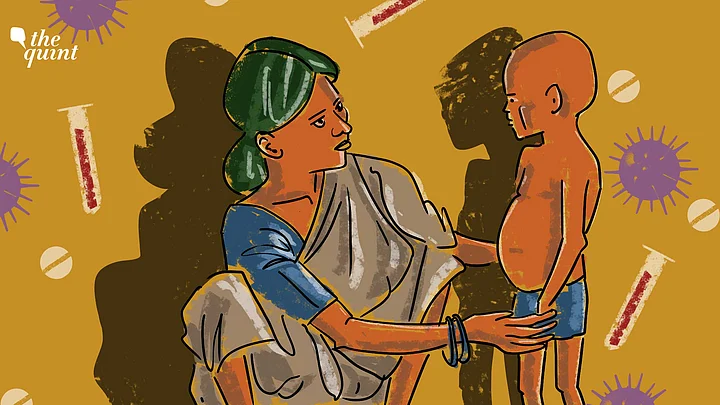The fifth round of the National Family Health Survey (NFHS-5), released by the Ministry of Health and Family Welfare on Wednesday, 24 November, shows an overall improvement in the country’s fertility, family planning, and health parameters. However, there are areas of concern with regard to nutritional status and anaemia among both women and children.
The 2021 Global Nutrition Report (GNR), released on 23 November, reveals that the world continues to face a nutrition crisis. Poor diets and resulting malnutrition in all its forms are excessively high across the globe, creating one of the most significant global challenges.
The COVID-19 pandemic is impeding progress towards achieving global nutrition targets. According to the report, India has made no progress on anaemia and childhood wasting, and over half of the Indian women in the age group of 15-49 years are anaemic.
What Did the Global Nutrition Report Find?
The findings of the Global Nutrition Report are corroborated by NFHS-5 (2019-21) data released this week. While stunting among children aged under five years has declined from 38 percent in 2015-16 to 36 percent in 2019-21, the NFHS-5 shows a marginal increase in the percentage of children under five years who are severely wasted, which means they are too thin for their height and is the result of recent rapid weight loss or failure to gain weight.
The severe wasting puts a child at an increased risk of death. There is an increase in the percentage of children under five years who are underweight.
The country faces a new challenge of having an increased percentage of children under five years who are overweight, especially in urban areas.
Anaemia among children and women continues to be a cause of concern. More than half of the children and women (including pregnant women) are anaemic in all the round-II states and union territories and all-India level compared to NFHS-4, in spite of the substantial increase in the composition of iron-folic acid (IFA) tablets for pregnant women for 180 days or more.
Anaemia among children aged 6-59 months has increased from 59 percent in 2015-16 to 67 percent in 2019-21. Moreover, 57 percent of women are anaemic as per NFHS-5 in comparison to 53 percent reported by NFHS-4.
The anaemia is much higher among adolescent girls. It has gone up from 54 percent in 2015-16 to 59 percent in 2019-21.
While 12 out of 36 states and union territories have reported a decline of 1 percentage point (pp) or more in anaemia among women of 15-49 years, 22 states have reported an increase in anaemia among them.
Assam (19.9 pp), Jammu and Kashmir (17 pp), and Ladakh (14.4 pp) reported the highest increase in 2019-21 compared to 2015-16.
As far as anaemia among women of 15-19 years is concerned, 20 out of 36 states and union territories have reported an increase. Jammu and Kashmir, Assam, and Chhattisgarh are the states with the highest percentage of anaemic girls aged 15-19 years, according to the NFHS-5.
India in Global Health Chart
Malnutrition is a global challenge, significantly impacting the health outcomes of women, infants, and children. The consequences of the nutrition and anaemia crisis are significant. In addition to being the attributable cause of one-third to half of child deaths, malnutrition causes stunted physical growth and cognitive development that last a lifetime.
Despite remarkable economic growth, of 107 countries, India ranks 94th on the 2020 Global Hunger Index.
The deterioration in child malnutrition could have been caused due to the all-round adverse impact of COVID-19 – be it personal incomes, food availability, or healthcare provisioning.
It is an established fact that healthy mothers are most likely to have healthy babies and healthy babies are most likely to achieve their potential in their lifetime.
The evidence shows that adolescent mothers are vulnerable to problems related to pregnancy and childbearing. Of all mothers, adolescent mothers are more likely to have preterm births. The prevailing social practices, such as early marriage, teenage pregnancy, unsafe abortion, lead to compromised nutritional and health status amongst the young girls and their children.
The NFHS-5 survey findings call for an integrated approach of programming by states. It is important for the government to ensure that mass campaigns, such as POSHAN Abhiyaan, become a community-owned, community-driven mission.
Increased community demand for services will lead to improved service delivery in the ICDS (Integrated Child Development Services) and other nutrition programmes. India’s nutrition strategy is not yet fully coupled with poverty or food security strategy. Accelerating targeting and co-location of existing safety net programmes (all cash transfers, Public Distribution System, Mahatma Gandhi National Rural Employment Guarantee Scheme) to vulnerable, 1,000-day families is an urgent starting point.
Finally, communication strategies targeting social and behavioural changes must be used to address the social determinants of health, such as early marriage and teenage pregnancy, and sensitise mothers, families and communities to adopt appropriate nutrition. Most nutrition is received at home, and families must adopt the right nutrition practices to avoid malnutrition and anaemia.
(Alok Vajpeyi, an experienced Development Professional, M&E Specialist, and Researcher with progressive experience in policy, research, and practice, leads the knowledge management in Population Foundation of India. This is an opinion piece and the views expressed are the author’s own. The Quint neither endorses nor is responsible for them.)
